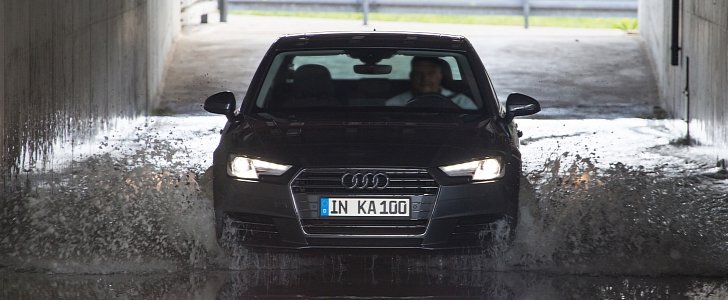Audi has completed its 100th corrosion and aging test, a procedure named INKA by the German brand.
The INKA test has the purpose of replicating 12 years of use in just 19 weeks of testing, and cars go through hell so that engineers can pull them apart once the test is completed.
Each vehicle that gets tested is dismantled to an average of 600 components, and engineers test tolerances and aging after the simulated wear that is predicted to occur over 12 years of use.
As Audi has explained, the INKA test is split over five phases. One of them includes a mist of salt sprayed in a climatic chamber that has 35 degrees Celsius inside. Upon inspection, the car is taken to a tropical climate simulator, where the temperature goes to a scorching 50 degrees Celsius, while humidity reaches a maximum of 100%.
Cars that go through this then move on to the simulation of extreme light. Audi places 80 high-power (1,200 watts) halogen metal vapor lamps to heat the car’s body. The metal reaches a maximum of 90 degrees Celsius, just ten away from the boiling point of water.
Once that test is completed, Audi technicians inspect all colors and materials, and check them with a set of samples to ensure nothing has degraded in quality, and that there are no brittle components.
After all this heat, Audi models put through the INKA test go to the simulated polar circle. There, the cars are held at minus 35 degrees Celsius. However, the vehicles do not just sit there. Instead of laying parked, they get rocked by a four-post machine, to simulate body torsion and strain on rough roads.
Each vehicle that passes this experiment is taken to the final phase of testing, where test drivers repeatedly drive within specially prepared routes on open testing grounds, which include intentionally bumpy roads, as well as other obstacles.
Audi says that each model that gets the INKA test procedure travels about 12,000 kilometers in 19 weeks. Each car is then dismantled and thoroughly tested, so that any weak points are dismissed before it reaches production.
The INKA tests per se have been conducted since 2002 by Audi Quality Assurance, but the same method has been in use by the Technical Development Department for 40 years. Audi estimates it has completed a total of 322,500 testing hours over the past 14 years, which have covered over one million kilometers.
Concerning procedures, the Germans have done 2,800 mud tests and 1,900 salt tests, much more than what any reasonable car would endure over its lifetime.
Each vehicle that gets tested is dismantled to an average of 600 components, and engineers test tolerances and aging after the simulated wear that is predicted to occur over 12 years of use.
As Audi has explained, the INKA test is split over five phases. One of them includes a mist of salt sprayed in a climatic chamber that has 35 degrees Celsius inside. Upon inspection, the car is taken to a tropical climate simulator, where the temperature goes to a scorching 50 degrees Celsius, while humidity reaches a maximum of 100%.
Cars that go through this then move on to the simulation of extreme light. Audi places 80 high-power (1,200 watts) halogen metal vapor lamps to heat the car’s body. The metal reaches a maximum of 90 degrees Celsius, just ten away from the boiling point of water.
Once that test is completed, Audi technicians inspect all colors and materials, and check them with a set of samples to ensure nothing has degraded in quality, and that there are no brittle components.
After all this heat, Audi models put through the INKA test go to the simulated polar circle. There, the cars are held at minus 35 degrees Celsius. However, the vehicles do not just sit there. Instead of laying parked, they get rocked by a four-post machine, to simulate body torsion and strain on rough roads.
Each vehicle that passes this experiment is taken to the final phase of testing, where test drivers repeatedly drive within specially prepared routes on open testing grounds, which include intentionally bumpy roads, as well as other obstacles.
Audi says that each model that gets the INKA test procedure travels about 12,000 kilometers in 19 weeks. Each car is then dismantled and thoroughly tested, so that any weak points are dismissed before it reaches production.
The INKA tests per se have been conducted since 2002 by Audi Quality Assurance, but the same method has been in use by the Technical Development Department for 40 years. Audi estimates it has completed a total of 322,500 testing hours over the past 14 years, which have covered over one million kilometers.
Concerning procedures, the Germans have done 2,800 mud tests and 1,900 salt tests, much more than what any reasonable car would endure over its lifetime.

































